Nacreous clouds
(Section 2.6.1)Ice polar stratospheric clouds, also known as mother-of-pearl clouds.
Definition
Clouds resembling Cirrus or Altocumulus lenticularis and showing very marked irisation, similar to that of mother of pearl; the most brilliant colours are observed when the Sun is several degrees below the horizon.
Physical constitution
Ice polar stratospheric clouds (nacreous clouds) form at temperatures below the ice frost point, typically near −85 °C, which is colder than the average lower stratosphere temperature. The characteristic bright iridescent colours, resulting from diffraction and interference of light waves, suggest that the clouds are composed of similarly sized spherical crystals of about 10 μm in diameter.
Explanatory remarks
Ice polar stratospheric clouds, or nacreous clouds, occur mainly at high latitudes during the winter when temperatures in the stratosphere fall below the frost point. They are most common in Antarctica, but have also been observed in the Arctic, Scotland, Scandinavia, Alaska, Canada and the northern Russian Federation. On rare occasions, they have been reported in other parts of northern Europe. Nacreous clouds are often lenticular wave clouds and thus are found downwind of mountain ranges that induce gravity waves in the stratosphere. Their formation may also be associated with severe tropospheric storms.
By day, nacreous clouds often resemble pale Cirrus. After sunset, they are characterized by brilliant iridescent colours, which are more extensive and more intense than the localized irisation, or iridescence, that often appears on the edges of thin tropospheric clouds (for example, Altocumulus lenticularis). Iridescence is most brilliant when the Sun is several degrees below the horizon. Later, with the Sun further below the horizon, the various colours are replaced by a general coloration that changes from orange to pink and contrasts vividly with the darkening sky.
If Cirrus and nacreous clouds coexist after sunset, the high altitude of the nacreous clouds causes them to show bright colours after the Cirrus has already turned grey. Nacreous clouds that are also lenticular will be stationary at the crest of a gravity wave, although the air flows through the cloud. Non-lenticular nacreous clouds may appear to move slowly, due to their distance from the observer, as they appear above the setting Sun.




